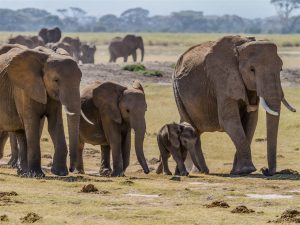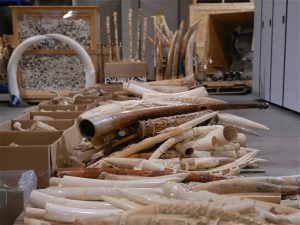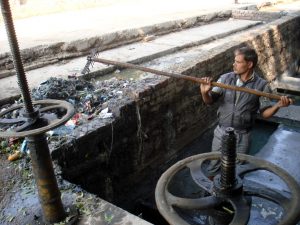China marked the end of 2016 by announcing that it would halt all commercial trade of domestic ivory in 2017, thereby fulfilling a commitment made in the China-US Strategic and Economic Dialogue in June.
While the announcement is progress for global efforts to ban ivory, it has been criticised for not going far enough to stamp out the black market trade that continues to fuel the slaughter of African elephants. As China is the world’s biggest market for ivory, the impact of new legislation could have a profound effect on the future of elephant conservation. But China’s policymakers will have to overcome some major challenges in implementing the ban.
We asked wildlife protectors and policy experts for their views on the ban.
John Scanlon, secretary-general of CITES
We see the announcement made by China as a response to a CITES COP17 decision that calls for the closure of domestic trade in elephant ivory in countries where the legal domestic market is contributing to poaching or illegal trade. As such, I would like to first congratulate China on the rapid progress in implementing the decision. This also reflects the ongoing strong efforts taken in China to tackle illegal wildlife trade and to fully implement CITES.
We can see some potential immediate and longer term challenges to implementing the ivory trade ban. Finding alternative livelihoods, including alternative carving materials for the licensed ivory carving factories, and the disposal of legal raw ivory and unsold worked ivory after the trade ban are probably the most immediate challenges. Few of the 34 enterprises that are legally licensed to process ivory depend solely on their ivory carving business and the total number of ivory carvers will likely be in the hundreds rather than thousands. In fact, we noticed that some master ivory carvers already started to use alternative materials a few years ago. As for the disposal of legal raw ivory and unworked ivory, we believe that the Chinese Government will be able to find a solution together with the enterprises.
Common with other countries, the long term challenges will likely be the enforcement of the ban, including ongoing efforts to prevent the laundering of ivory carvings, such as with mammoth ivory and antique elephant ivory carvings, both of which will remain legal after the ban. Furthermore, the ultimate goal of the ban is to eradicate illegal trade in ivory. The ban itself does not negate the need for continued efforts in law enforcement and international cooperation to end poaching, the trafficking in ivory and efforts to reduce demand for illegal ivory.
In implementing the ivory trade ban China will be able to draw on the significant experience gained through the successful implementation of the domestic ban on trade in medicines containing rhinoceros horn since 1993.
At the invitation of the State Forestry Administration, I am looking forward to returning to China to visit some of the factories and shops whose ivory carving and sales business will be shut down before the end of March. We will understand the situation and challenges better by that time.
Zhang Li, member of the Technical Advisory Group for the CITES MIKE (Monitoring of Illegal Killing of Elephants) project, and professor at Beijing Normal University
China’s total ban on the ivory trade removes any legitimacy from this practice in China. This is the world’s most complete ivory ban, showing China to be a responsible nation.
Both Chinese and US leaders have said they want to ban trading in ivory and states including California, New York, New Jersey and Hawaii have already put legislation in place to do so, with other states to follow. Although both China and the US are major buyers of ivory, the trade is a global issue. The killing won’t stop till the trade does and so other places where the trade continues, such as Japan, Vietnam, Thailand, the EU and Africa, should implement their own bans.
Research has found that ivory purchases are directly correlated with economic growth. China’s economy is expanding quickly and purchasing power is increasing – much confiscated ivory is bound for China or Chinese communities and China has come in for much international criticism over ivory. But China has made huge efforts to protect endangered species around the world. For example, it has banned the trade in rhino horn and tiger bones, both ingredients in Chinese medicine.
The comprehensive ban on ivory trading will make law enforcement easier, as it will no longer be possible to launder illegal ivory into legitimate trading channels and officials will no longer need to determine if a particular piece of ivory is illegal or not. But the new policy will need to be backed up by measures, such as better management of ivory certification. Ivory can still be donated or inherited and in theory legal pieces of ivory and ivory products should have a numbered certificate to allow for it to be passed on in the future. If those certificates are not better managed we will see problems in the future.
Aron White, wildlife campaigner with the Environmental Investigation Agency (EIA)
China’s announcement of a timeframe for closing its domestic ivory market represents a major win for global elephant conservation and the Chinese Government deserves commendation – although examination of the detail gives some cause for concern.
EIA investigations have long documented widespread abuse of China’s poorly regulated domestic market which enabled the laundering of illegally sourced ivory. For example, in 2010, EIA investigators were told by ivory retailers in southern China that 90% of ivory products on sale came from illegal sources. Its closure could massively simplify enforcement operations because without a legal market to launder ivory any processing or sale is illegal and can be dealt with immediately.
However, the government’s notification contains a potential loophole allowing “cultural relics made of ivory that are of legal origin and have been verified by a specialist appraisal body” to be auctioned under strict supervision. “Cultural relic” usually refers to antiques, but not explicitly so. This suggests that trade in ivory antiques and possibly any ivory item judged to have artistic merit and created or sold under the previous licensing system could continue, regardless of age. This sends an ambiguous message and risks undermining the effectiveness of the ban and related demand reduction campaigns.
Furthermore, the Chinese government and the international community must take meaningful steps to ensure the ivory market does not simply shift to other areas with weak enforcement or lax legislation, especially in countries bordering China such as Laos, Myanmar and Vietnam.
Overall, it is imperative that potential loopholes are closed and the ban strongly publicised and rigorously enforced.
Wang Weisheng, deputy head of the State Forestry Administration’s Department of Wildlife and Nature Reserves
The Chinese government has put forward a clear timetable to halt the trade in ivory. This shows China is not just paying lip service to the protection of elephants, it is taking action and putting measures in place. Over the course of a year we will shut down all domestic ivory trading. Between now and March 31, 10 to 15 ivory processing firms and 50 to 60 sales outlets will be shut down, with the others all to close by the end of 2017. Currently China has 34 ivory processing firms and 143 sales outlets. This will take a year as ivory carvers and the companies will need time to change their businesses or find new employment, so this is the only way to ensure an orderly end to the market.
China has already taken resolute action to protect elephants. We hope this will prompt other nations to follow suit in combating poaching and the illegal ivory trade, working together to end the trade at the source. This new policy should be followed up with further measures bolstering enforcement and education to raise public awareness of elephant conservation.
The continued existence of legal ivory markets in some countries will reduce the effectiveness of international efforts to combat the illegal ivory trade. We need to realise that saving the African elephant requires action on a global scale, not just by a handful of countries. All nations, from the sources of the ivory, to nations through which ivory transits, to the final consumers, must take what action they can. Only a joint approach will save the elephants.
Grace Gabriel, Asia regional director at the International Fund for Animal Welfare
China’s move to shut down the domestic ivory market is of historical importance for the protection of elephants. In an independent survey 60% of ivory purchasers said they would no longer buy ivory if the government imposed a comprehensive ban on the trade.
China’s policies on the ivory trade have been shown to have a huge impact on the market. In 2011, ivory and rhinoceros horn were regarded as investments, with prices reaching unprecedented highs. At the end of that year China banned auctions of ivory, rhinoceros horn and tiger bones – and ivory sales and prices plummeted 90%. But China has faced pressure both internationally and from domestic media and businesses to ban the ivory trade. Public awareness of conservation is also steadily increasing.
Currently not all African elephants are listed in CITES Appendix I, which offers the highest level of protection, and poaching is still causing elephant populations to shrink by 8% annually. Certain southern African nations and international smuggling syndicates hope to see international ivory markets reopen. The existence of legal ivory markets in some nations encourages smuggling. There are domestic ivory markets in Japan, the UK and the EU, all of which inevitably provide cover for the laundering of illegal ivory. We hope those nations will follow China’s lead and ban the ivory trade entirely.








